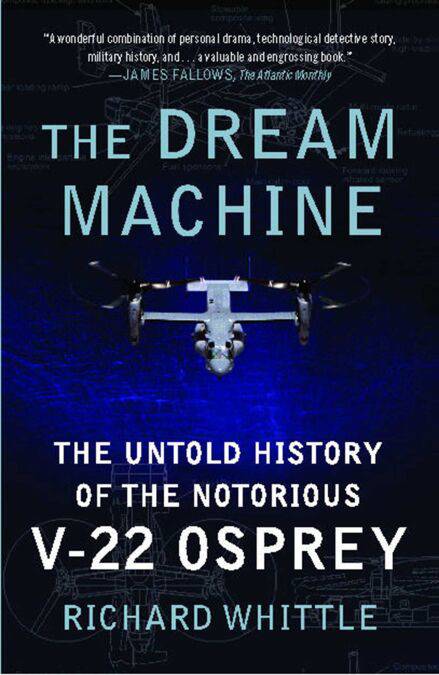
- Retrait gratuit dans votre magasin Club
- 7.000.000 titres dans notre catalogue
- Payer en toute sécurité
- Toujours un magasin près de chez vous
- Retrait gratuit dans votre magasin Club
- 7.000.0000 titres dans notre catalogue
- Payer en toute sécurité
- Toujours un magasin près de chez vous
The Dream Machine EBOOK
The Untold History of the Notorious V-22 Osprey
Richard Whittle
Ebook | Anglais
17,88 €
+ 17 points
Format
Description
A fascinating and authoritative narrative history of the V-22 Osprey, revealing the inside story of the most controversial piece of military hardware ever developed for the United States Marine Corps.
When the Marines decided to buy a helicopter-airplane hybrid “tiltrotor” called the V-22 Osprey, they saw it as their dream machine. The tiltrotor was the aviation equivalent of finding the Northwest Passage: an aircraft able to take off, land, and hover with the agility of a helicopter yet fly as fast and as far as an airplane. Many predicted it would reshape civilian aviation. The Marines saw it as key to their very survival.
By 2000, the Osprey was nine years late and billions over budget, bedeviled by technological hurdles, business rivalries, and an epic political battle over whether to build it at all. Opponents called it one of the worst boondoggles in Pentagon history. The Marines were eager to put it into service anyway. Then two crashes killed twenty-three Marines. They still refused to abandon the Osprey, even after the Corps’ own proud reputation was tarnished by a national scandal over accusations that a commander had ordered subordinates to lie about the aircraft’s problems.
Based on in-depth research and hundreds of interviews, The Dream Machine recounts the Marines’ quarter-century struggle to get the Osprey into combat. Whittle takes the reader from the halls of the Pentagon and Congress to the war zone of Iraq, from the engineer’s drafting table to the cockpits of the civilian and Marine pilots who risked their lives flying the Osprey—and sometimes lost them. He reveals the methods, motives, and obsessions of those who designed, sold, bought, flew, and fought for the tiltrotor. These stories, including never before published eyewitness accounts of the crashes that made the Osprey notorious, not only chronicle an extraordinary chapter in Marine Corps history, but also provide a fascinating look at a machine that could still revolutionize air travel.
When the Marines decided to buy a helicopter-airplane hybrid “tiltrotor” called the V-22 Osprey, they saw it as their dream machine. The tiltrotor was the aviation equivalent of finding the Northwest Passage: an aircraft able to take off, land, and hover with the agility of a helicopter yet fly as fast and as far as an airplane. Many predicted it would reshape civilian aviation. The Marines saw it as key to their very survival.
By 2000, the Osprey was nine years late and billions over budget, bedeviled by technological hurdles, business rivalries, and an epic political battle over whether to build it at all. Opponents called it one of the worst boondoggles in Pentagon history. The Marines were eager to put it into service anyway. Then two crashes killed twenty-three Marines. They still refused to abandon the Osprey, even after the Corps’ own proud reputation was tarnished by a national scandal over accusations that a commander had ordered subordinates to lie about the aircraft’s problems.
Based on in-depth research and hundreds of interviews, The Dream Machine recounts the Marines’ quarter-century struggle to get the Osprey into combat. Whittle takes the reader from the halls of the Pentagon and Congress to the war zone of Iraq, from the engineer’s drafting table to the cockpits of the civilian and Marine pilots who risked their lives flying the Osprey—and sometimes lost them. He reveals the methods, motives, and obsessions of those who designed, sold, bought, flew, and fought for the tiltrotor. These stories, including never before published eyewitness accounts of the crashes that made the Osprey notorious, not only chronicle an extraordinary chapter in Marine Corps history, but also provide a fascinating look at a machine that could still revolutionize air travel.
Spécifications
Parties prenantes
- Auteur(s) :
- Editeur:
Contenu
- Nombre de pages :
- 464
- Langue:
- Anglais
Caractéristiques
- EAN:
- 9781416563198
- Date de parution :
- 26-04-10
- Format:
- Ebook
- Protection digitale:
- Adobe DRM
- Format numérique:
- ePub

Les avis
Nous publions uniquement les avis qui respectent les conditions requises. Consultez nos conditions pour les avis.






